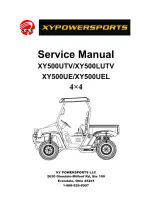
B
48
Repair and Service Manual
BATTERIES AND CHARGING
Read all of SAFETY and this section before attempting any procedure. Pay particular attention to Notices, Cautions, Warnings and Dangers.
634756
Battery Replacement
Before any electrical service is performed, the Run-
Tow/Maintenance switch must be placed in the ‘Tow/
Maintenance’ position.
If a power wire (battery, motor or controller) is discon-
nected for any reason, the Run-Tow/Maintenance switch
must be left in the ‘Tow/Maintenance’ position for at least
30 seconds after the circuit is restored.
Remove battery hold downs and cables. Lift out batteries
with a commercially available lifting device.
If the batteries have been cleaned and any acid in the
battery rack area neutralized as recommended, no corro-
sion to the battery racks or surrounding area should be
present. Any corrosion found should be immediately
removed with a putty knife and a wire brush. The area
should be washed with a solution of sodium bicarbonate
(baking soda) and water, thoroughly dried and then
primed/painted with a corrosion resistant paint.
The batteries should be placed into the battery racks and
the battery hold downs tightened to 45 - 55 in. lbs. (5 - 6
Nm) torque; tight enough to prevent movement but not
tight enough to distort battery cases.
Inspect all wires and terminals. Clean any corrosion from
the battery terminals or the wire terminals with a solution
of sodium bicarbonate (baking soda) and brush clean if
required.
To prevent battery explosion that could result
in severe personal injury or death, extreme
care must be used with aerosol containers of
battery terminal protectant.
Insulate the aerosol container to prevent the
metal can from contacting battery terminals,
which could result in an explosion.
Use care to connect the battery wires as shown (Ref. Fig.
5). Ensure that all battery terminals are installed with
crimp facing up. Tighten the battery post hardware to 90 -
100 in. lbs. (6 - 8 Nm) torque. Do not overtighten the ter-
minal nut, causing a "mushroom" effect on the battery
post and preventing the terminal nut from being properly
tightened. Protect the battery terminals and battery wire
terminals with a commercially available protective coat-
ing.
.
Fig. 5 Battery Connections
Prolonged Storage
Disconnect battery charger, controller and other
electronic devices since they will contribute to the
premature discharge of batteries.
During storage periods, the batteries will need proper
maintenance to prevent discharge.
In high temperatures the chemical reaction is faster, while
low temperatures cause the chemical reaction to slow
down. A vehicle that is stored at 90° F (32° C) will lose
.002 of specific gravity each day. If a fully charged battery
has a specific gravity of 1.275, and the battery is allowed
to sit unused, it will become partially discharged. When it
reaches 1.240, which it will do in less than twenty days, it
should be recharged.
If a battery is left in a discharged state, sulfating takes
place on and within the plates. This condition is not
reversible and will permanently damage the battery. In
order to prevent damage, the battery should be recharged
as necessary.
A hydrometer (P/N 50900-G1) can be used to determine
the specific gravity and therefore the state of charge of a
battery.
In winter conditions, the battery must be fully charged to
prevent the possibility of freezing (Ref. Fig. 6). A fully
charged battery will not freeze in temperatures above -
75° F (-60° C). Although the chemical reaction is slowed
in cold temperatures, the battery must be stored fully
charged, and disconnected from any circuit that could dis-
charge the battery. For portable chargers, disconnect the
charging plug from the vehicle receptacle. For on-board
chargers, disconnect the charging harness from the bat-
teries.
Remove battery cable
from (-) battery termina
Front of
Vehicle
















































